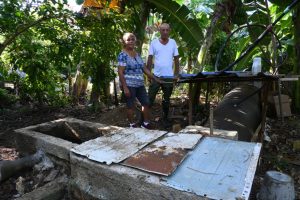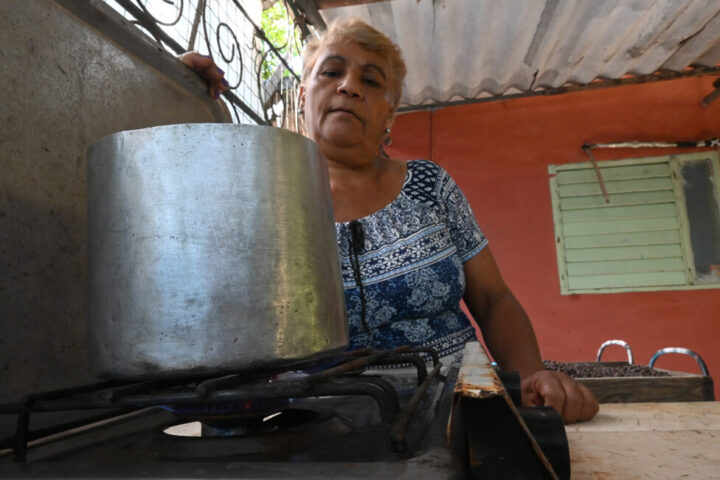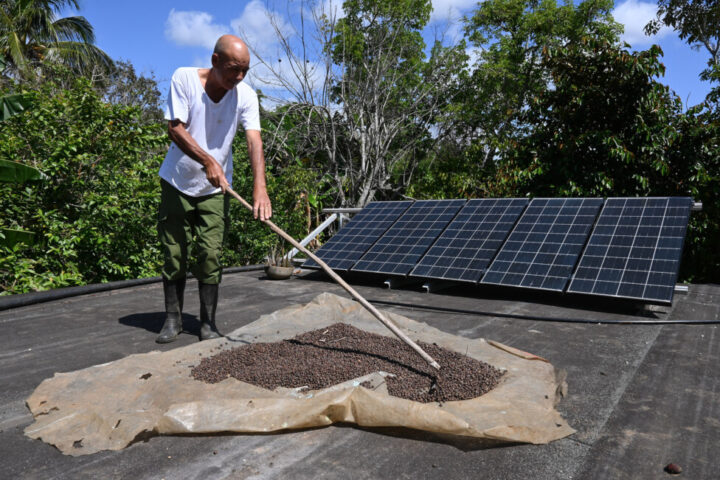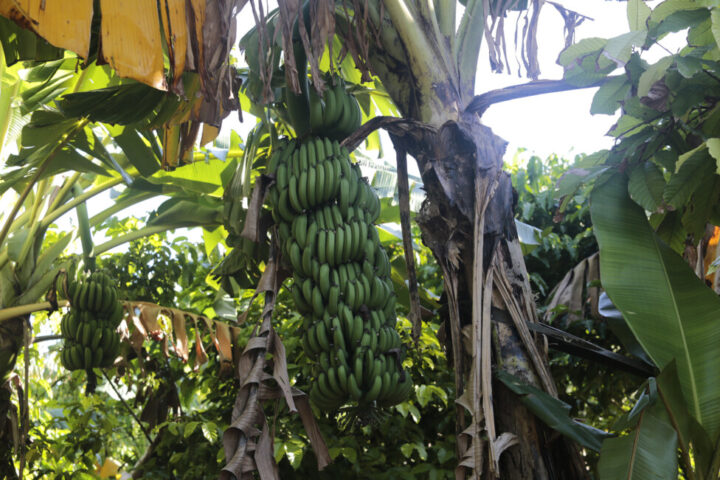Cuban Family Harnesses Biogas and Promotes its Benefits
Latest World News
Preschool teacher Iris Mejías and her husband Alexis García, a retired university professor, stand next to the geomembrane biodigester that since December 2023 provides about four cubic meters of biogas daily for their agricultural activities and the needs of their home in the semi-urban neighborhood of Sierra Maestra, in the municipality of Boyeros on the south side of Havana. CREDIT: Jorge Luis Baños / IPS
By Luis Brizuela
HAVANA, Apr 26 2024 – Just to obtain a good fertilizer it was worth building a biodigester, says Cuban farmer Alexis García, who proudly shows the vegetables in his family’s garden, as well as the wide variety of fruit trees that have benefited from biol, the end product of biogas technology.
García and his wife Iris Mejías organically grow all the agricultural products that make them self-sufficient, on the land around their home in the semi-urban neighborhood of Sierra Maestra, in the municipality of Boyeros on the south side of Havana.“We need a greater culture and awareness about renewable energies. There is resistance among some places and people. On the other hand, there are the high prices which do not foment the rapid expansion of technologies and equipment.” — Alexis García
“I used to use a little urea, but because of the economic situation it has become very difficult to import this and other fertilizers. The bioproducts are an opportunity to make up for that shortage and, in some cases, function as pesticides,” García, a 62-year-old retired university professor who is now dedicated to his crops, told IPS.
Biol is the liquid effluent with a certain degree of stabilization that comes out of the biodigester, once the process of anaerobic digestion of organic matter, which includes animal manure, crop waste and/or liquid waste, has been completed. It is rich in nutrients for crops and for restoring soil through fertigation.
García pointed out that the challenges of obtaining energy and the need to process manure prompted the installation of the geomembrane biodigester, which as of December 2023 provides about four cubic meters of biogas per day.
This is one of the three types of biodigesters most used at a small and medium scale in Cuba, together with the mobile type, also known as the Indian model, and the fixed dome or Chinese biodigester.
“I had read a little about it and wanted to have a biodigester. With some savings we decided to start building one. In addition to the support of our sons Alexis and Alexei, we had the backing and advice of José Antonio Guardado,” coordinator of the Biogas Users Movement (MUB), said García.
Founded in 1983, the MUB brings together some 3,000 farmers who use this technology in this Caribbean island nation of 11 million people.

Preschool teacher Iris Mejías uses biogas to cook food, which gives her autonomy, saves money and improves the quality of life in her home in the south of the Cuban capital. CREDIT: Jorge Luis Baños / IPS
Biogas opportunities
Mejías, 59, said that “with biogas you lose the fear of not having enough fuel for cooking. It provides security.”
Meiías, a teachers at a preschool for the young children of working mothers, says that when the economic crisis became more severe in the 1990s, she cooked with firewood, charcoal, kerosene and even coconut shells to prepare her family’s daily meals.
“If you cook with electrical equipment, you depend on the power supply, or if you have a gas cylinder (liquefied petroleum gas), you worry that it will run out and you won’t have a spare. In both cases the biodigester saves money,” she said.
Mejías said it is easier to cook food for domestic animals and heat water “without smut or smoke that makes it necessary to wash your hair every day or makes it difficult to take care of your hands.”
Studies show that methane is a potent greenhouse gas, with a warming power 80 times greater than that of carbon dioxide (CO2).
Proper management of the biological methane resulting from the decomposition of agricultural residues and manure can generate value and be a cost-effective solution to avoid water and soil contamination.
Therefore, its extraction and use as energy, especially in rural and semi-urban environments, can be a solution to reduce electricity consumption and help combat climate change.
According to García, the island could receive greater energy benefits if there were clear incentives for the installation of biodigesters.
Although the acute domestic economic crisis has had a very negative impact on the national swine and cattle herd, “many dairies and pig farms do not know what to do with the daily output of manure. In fact, our biodigester is fed from nearby facilities where it is piled up and they give it to us for free,” he said.

Alexis García dries coffee beans next to solar panels installed on the roof of his house in southern Havana. The possibility of storing energy with the back-up of recovered batteries provides the family with approximately three hours of autonomy during blackouts. CREDIT: Jorge Luis Baños / IPS
Other incentives
Cuba has a biogas production potential of 615,595 cubic meters per year from agricultural and industrial production, according to the Bioenergy Atlas 2022.
That volume represents 189,227 tons of oil equivalent per year or 710,095 megawatt hours (MWh) per year. Of the total, 63 percent comes from agricultural production, he said.
In García’s opinion, Cuba’s rural environment “is in a better position to achieve the desired energy independence. But economic facilities would be necessary, such as loans for the construction of biodigesters, bonuses for people to produce that energy and access to buy lamps, pots and even refrigerators that use biogas.”
Of Cuba’s 11 million inhabitants, about 23 percent, some 2.3 million people, live in rural areas, according to official statistics.
On the other hand, it is estimated that there are some 5,000 biodigesters on the island, although conservative estimates by specialists consider it possible to expand the network to 20,000 family units.
Experts argue that the direct use of biogas is more efficient than transforming it into electricity.
A significant percentage of Cuba’s four million households use electricity as the main energy source for cooking and heating water for bathing, which represents about 40 percent of consumption.
Cuba is a country highly dependent on fuel imports.
During the last five years, in parallel to the deterioration of the domestic economic situation, the decline of the main sources of foreign currency and the strengthening of the U.S. embargo, the authorities have faced increasing difficulties in meeting the demand for fuel.
About 95 percent of Cuba’s electricity generation relies on fossil fuels. The government aims to increase clean sources from the current five percent to around 30 percent of electricity generation by 2030.
“Imagine what it would mean if not all, at least most of the houses in the Cuban countryside had a biodigester or solar panels. Any strategy that encourages independence from the national power grid, or that provides energy, would be very positive,” said García.
In recent years, the international Biomas-Cuba project (2009-2022) focused on helping to understand the importance of renewable energy sources in rural environments, the role of on-farm biodigesters and waste treatment systems in swine facilities.
The initiative, financed by the Swiss Agency for Development and Cooperation (Cosude), was coordinated by the Indio Hatuey Experimental Station, a research center attached to the University of the western province of Matanzas, and involved related institutions in several of the country’s 15 provinces.
Ministerial Order 395 of the Ministry of Energy and Mines of 2021 stipulated that each of Cuba’s 168 municipalities must have a biogas development program and strategy, and coordinate its management and implementation with their respective provinces.
In addition, the non-governmental Cuban Society for the Promotion of Renewable Energy Sources and Respect for the Environment (Cubasolar), together with the MUB, encourages training workshops and the advice of specialists.

Banana clusters can be seen growing in the backyard of the García-Mejías home in southern Havana. Both the vegetables in the nursery and the fruit trees benefit from biol, the end product of biogas technology, which provides fertilizer. CREDIT: Jorge Luis Baños / IPS
Moving towards energy independence
One of the aspirations of the García-Mejías family is to achieve energy sustainability for their home and agricultural production.
“We foresee the construction of a second biodigester, but this one will have a mobile dome, which should provide two cubic meters of biogas per day, but much more efficiently, and with a higher pressure. With a higher volume we can benefit some neighbors,” García said.
On the roof of their house, six 720-watt solar panels backed up by recovered batteries give them autonomy of approximately three hours of electricity in the event of a power failure.
“We plan to install a wind turbine, as well as a solar heater made of plastic pipes. We want to set up a demonstration area in the house to show the advantages of renewable energies and demonstrate how everything we do is done using these energy sources,” said the former professor.
“We need a greater culture and awareness about renewable energies. There is resistance among some places and people. On the other hand, there are the high prices which do not foment the rapid expansion of technologies and equipment,” García said when IPS asked him in his home about the obstacles to increasing the household use of renewables.
“People hear about the biodigester and think it’s difficult. It takes a little work, but then the benefits are many. There is a lack of information in the media. People come to us looking for help in building biodigesters. We also receive students, which opens up an opportunity for the new generations to grow up with the culture of using nature in a sustainable way,” he added.








